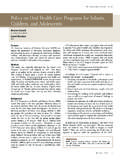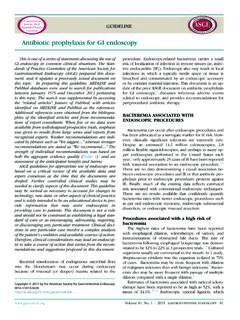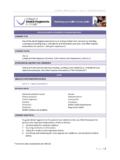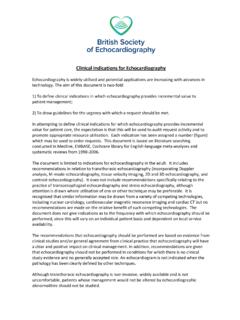Transcription of Guideline on Antibiotic Prophylaxis for Dental Patients at ...
1 328 CLINICAL PRACTICE GUIDELINES328232 C2 LIN ANPLLLLLRLTELGL ULDLLLLLSDLGLSoPurposeThe American Academy of Pediatric Dentistry (AAPD) recog-nizes that numerous medical conditions predispose Patients to bacteremia-induced infections. Because it is not possible to predict when a susceptible patient will develop an infection, prophylactic antibiotics are recommended when these Patients undergo procedures that are at risk for producing bacteremia. This Guideline is intended to help practitioners make decisions regarding Antibiotic Prophylaxis for Dental Patients at Guideline was originally developed by the Council on Clinical Affairs and adopted in 1990. This document is a revision of the previous version, last revised in 2011, and based on a review of current Dental and medical literature pertaining to post procedural bacteremia-induced infections.
2 This docu- ment included database searches using key terms: infective endocarditis (IE), bacteremia, Antibiotic Prophylaxis , and Dental infection. Articles were evaluated by title and/or abs- tract and relevance to Dental care for children, adolescents, and those with special health care needs. Thirty-one citations were chosen from this method and from references within selected articles. When data did not appear sufficient or were incon- clusive, recommendations were based upon expert and/or consensus opinion by experienced researchers and clinicians. In addition, prevention of infective endocarditis : Guidelines from the American Heart Association 1,2 and prevention of orthopedic implant infection in Patients undergoing Dental procedures: Guidelines from the American Academy of Orthopedic Surgeons (AAOS) and American Dental Associa- tion (ADA) 3,4 were reviewed.
3 Background Bacteremia, bacteria in the bloodstream, is anticipated follow-ing invasive Dental ,6 infective endocarditis is an uncommon but life-threatening complication resulting from bacteremia. The incidence of infections such as IE ranges from to per 100,000 person-years with a significant increasing trend among Only a limited number of bacterial species have been implicated in resultant postoper- ative infections. Viridans group streptococci, Staphylococcus aureus, enterococcus, pseudomonas, serratia, and candida are some of the microorganisms implicated with ,2 The vast majority of cases of IE caused by oral microflora can result from bacteremia associated with routine daily activities such as toothbrushing, flossing, and ,2 However, Antibiotic Prophylaxis is recommended with certain Dental proce- ,2,5,6 An effective Antibiotic regimen should be directed against the most likely infecting organism, with antibiotics administered shortly before the procedure.
4 When procedures involve infected tissues or are performed on a patient with a compromised host response, additional doses or a prescribed postoperative regimen of antibiotics may be usage may result in the development of resistant ,2,5,6,8,9 Utilization of Antibiotic Prophylaxis for Patients at risk does not provide absolute prevention of infec- tion. Post-procedural symptoms of acute infection ( , fever, malaise, weakness, lethargy) may indicate Antibiotic failure and need for further medical evaluation. The decision to use Antibiotic Prophylaxis should be made on an individual basis. Some medical conditions that may predispose Patients to post-procedural infections are discussed below. This is not intended to be an exhaustive list; rather, the categorization should help practitioners identify children who may be at increased risk.
5 If a patient reports a syndrome or medical condition with which the practitioner is not familiar, it is appropriate to contact the child s physician to determine susceptibility to bacteremia-induced 2007, the American Heart Association (AHA) released its newly revised guidelines for the prevention of IE and re-ducing the risk for producing resistant strains of ,2 The AAPD, acknowledging the AHA s expertise and efforts to produce evidenced-based recommendations, continues to endorse the AHA Guideline for Antibiotic Prophylaxis , entitled prevention of infective endocarditis .The significant reasons for the revision include1,2: IE is much more likely to result from frequent exposure to random bacteremias associated with daily activities than from bacteremia caused by a Dental , GI tract, or GU tract procedure.
6 1 (Daily activities would include tooth-brushing, flossing, chewing, using toothpicks, using water irrigation devices, and other activities.) Prophylaxis may prevent an exceedingly small number of cases of IE if any, in individuals who undergo a Dental , GI tract, or GU tract procedure. Review CouncilCouncil on Clinical AffairsLatest Revision2014 Guideline on Antibiotic Prophylaxis for Dental Patients at Risk for Infection AMERICAN ACADEMY OF PEDIATRIC DENTISTRY CLINICAL PRACTICE GUIDELINES 329 The risk of Antibiotic -associated adverse events exceeds the benefit, if any, from prophylactic Antibiotic therapy. Maintenance of optimal oral health and hygiene may re- duce the incidence of bacteremia from daily activities and is more important than prophylactic antibiotics for a Dental procedure to reduce the risk of IE.
7 1 The 2007 AHA revision was intended to clarify when anti- biotic Prophylaxis is/is not recommended and to provide more uniform global recommendations. Major changes from the 1997 version1,2,8 include: The Committee concluded that only an extremely small number of cases of infective endocarditis might be pre- vented by Antibiotic Prophylaxis for Dental procedures even if such prophylactic therapy were 100 percent effective. infective endocarditis Prophylaxis for Dental procedures is reasonable only for Patients with underlying cardiac conditions associated with the highest risk of adverse outcome from infective endocarditis . For Patients with these underlying cardiac conditions, Prophylaxis is reasonable for all Dental procedures that involve manipulation of gingival tissue or the periapical region of teeth or perforation of the oral mucosa.
8 Prophylaxis is not recommended based solely on an increased lifetime risk of acquisition of infective endo- carditis. 1 RecommendationsThe conservative use of antibiotics is indicated to minimize the risk of developing resistance to current Antibiotic ,7,8 Given the increasing number of organisms that have developed resistance to current Antibiotic regimens, as well as the poten- tial for an adverse anaphylactic reaction to the drug admin- istered, it is best to be judicious in the use of antibiotics for the prevention of IE1,2 and other distant-site with cardiac conditionsDental practitioners should consider prophylactic measures to minimize the risk of IE in Patients with underlying cardiac conditions. The risk of developing IE can arise from a combi- nation of high-risk Patients and Dental procedures.
9 However, at-risk Patients with poor oral hygiene and gingival bleeding after routine activities ( , toothbrushing) also have shown an increased potential for developing complications of ,2,12,13 It, therefore, is recommended to encourage daily good oral hygiene practices to reduce gingivitis as part of the prophylactic ,2,11,12 These Patients and/or parents need to be educated and motivated to maintain personal oral hygiene through daily plaque removal, including ,2 Greater emphasis should be placed on improved access to Dental care and oral health in Patients with underlying cardiac condi-tions at high risk for IE and less focus on a Dental procedure and Antibiotic ,2,10-12 Professional prevention strategies should be based upon the individual s assessed risk for caries and periodontal disease.
10 Specific recommendations from the 2007 AHA Guideline on prevention of IE are included in the following tables. The AHA recommends Antibiotic Prophylaxis only for those whose underlying cardiac conditions are associated with the highest risk of adverse outcome1,2 (see Table 1). Such con- ditions include prosthetic heart valves or prosthetic material used for cardiac valve repair, a previous history of IE unre-paired or incompletely repaired cyanotic congenital heart disease (CHD) including palliative shunts and conduits, com-pletely repaired congenital heart defect with prosthetic material or device (whether placed by surgery or by catheter intervention) during the first six months after the procedure, and repaired CHD with residual defects at the site or adjacent to the site of a prosthetic patch or device, and cardiac transplantation recipients who develop cardiac valvulopathy such as valve regurgitation due to a structurally abnormal ,2,14 After the 2007 AHA revised guidelines were published.














